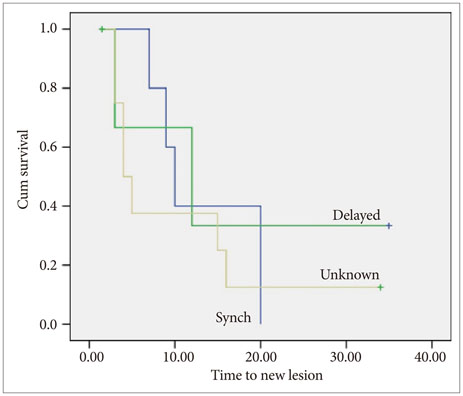Brain Tumor Res Treat.
2016 Oct;4(2):107-110. 10.14791/btrt.2016.4.2.107.
Optimal Treatment Decision for Brain Metastases of Unknown Primary Origin: The Role and Timing of Radiosurgery
- Affiliations
-
- 1Department of Neurosurgery, Yonsei University Health System, Seoul, Korea. changjh@yuhs.ac
- 2Brain Tumor Center, Yonsei University Health System, Seoul, Korea.
- 3Gamma Knife Center, Yonsei University Health System, Seoul, Korea.
- 4Department of Neurosurgery, Haeundae Paik Hospital, Inje University College of Medicine, Busan, Korea. hykim0803@naver.com
- KMID: 2356978
- DOI: http://doi.org/10.14791/btrt.2016.4.2.107
Abstract
- BACKGROUND
Up to 15% of all patients with brain metastases have no clearly detected primary site despite intensive evaluation, and this incidence has decreased with the use of improved imaging technology. Radiosurgery has been evaluated as one of the treatment modality for patients with limited brain metastases. In this study, we evaluated the effectiveness of radiosurgery for brain metastases from unknown primary tumors.
METHODS
We retrospectively evaluated 540 patients who underwent gamma knife radiosurgery (GKRS) for brain metastases radiologically diagnosed between August 1992 and September 2007 in our institution. First, the brain metastases were grouped into metachronous, synchronous, and precocious presentations according to the timing of diagnosis of the brain metastases. Then, synchronous and precocious brain metastases were further grouped into 1) unknown primary; 2) delayed known primary; and 3) synchronous metastases according to the timing of diagnosis of the primary origin. We analyzed the survival time and time to new brain metastasis in each group.
RESULTS
Of the 540 patients, 29 (5.4%) presented precocious or synchronous metastases (34 GKRS procedures for 174 lesions). The primary tumor was not found even after intensive and repeated systemic evaluation in 10 patients (unknown primary, 34.5%); found after 8 months in 3 patients (delayed known primary, 1.2%); and diagnosed at the same time as the brain metastases in 16 patients (synchronous metastasis, 55.2%). No statistically significant differences in survival time and time to new brain metastasis were found among the three groups.
CONCLUSION
Identification of a primary tumor before GKRS did not affect the patient outcomes. If other possible differential diagnoses were completely excluded, early GKRS can be an effective treatment option for brain metastases from unknown primary tumor.
MeSH Terms
Figure
Reference
-
1. Patchell RA. The management of brain metastases. Cancer Treat Rev. 2003; 29:533–540.
Article2. Andrews DW, Scott CB, Sperduto PW, et al. Whole brain radiation therapy with or without stereotactic radiosurgery boost for patients with one to three brain metastases: phase III results of the RTOG 9508 randomised trial. Lancet. 2004; 363:1665–1672.
Article3. Aoyama H, Shirato H, Tago M, et al. Stereotactic radiosurgery plus whole-brain radiation therapy vs stereotactic radiosurgery alone for treatment of brain metastases: a randomized controlled trial. JAMA. 2006; 295:2483–2491.
Article4. Chang EL, Wefel JS, Hess KR, et al. Neurocognition in patients with brain metastases treated with radiosurgery or radiosurgery plus whole-brain irradiation: a randomised controlled trial. Lancet Oncol. 2009; 10:1037–1044.
Article5. Kocher M, Soffietti R, Abacioglu U, et al. Adjuvant whole-brain radiotherapy versus observation after radiosurgery or surgical resection of one to three cerebral metastases: results of the EORTC 22952-26001 study. J Clin Oncol. 2011; 29:134–141.6. Pirzkall A, Debus J, Lohr F, et al. Radiosurgery alone or in combination with whole-brain radiotherapy for brain metastases. J Clin Oncol. 1998; 16:3563–3569.
Article7. Debevec M. Management of patients with brain metastases of unknown origin. Neoplasma. 1990; 37:601–606.8. Le Chevalier T, Smith FP, Caille P, Constans JP, Rouesse JG. Sites of primary malignancies in patients presenting with cerebral metastases. A review of 120 cases. Cancer. 1985; 56:880–882.
Article9. Nguyen LN, Maor MH, Oswald MJ. Brain metastases as the only manifestation of an undetected primary tumor. Cancer. 1998; 83:2181–2184.
Article10. D’Ambrosio AL, Agazzi S. Prognosis in patients presenting with brain metastasis from an undiagnosed primary tumor. Neurosurg Focus. 2007; 22:E7.11. Maesawa S, Kondziolka D, Thompson TP, Flickinger JC, Dade L. Brain metastases in patients with no known primary tumor. Cancer. 2000; 89:1095–1101.
Article12. Agazzi S, Pampallona S, Pica A, et al. The origin of brain metastases in patients with an undiagnosed primary tumour. Acta Neurochir (Wien). 2004; 146:153–157.
Article13. Gerosa M, Nicolato A, Foroni R, et al. Gamma knife radiosurgery for brain metastases: a primary therapeutic option. J Neurosurg. 2002; 97:5 Suppl. 515–524.
Article14. Black PJ, Page BR, Lucas JT Jr, et al. Factors that determine local control with gamma knife radiosurgery: The role of primary histology. J Radiosurg SBRT. 2015; 3:281–286.15. Bouillot-Eimer S, Loiseau H, Vital A. Subcutaneous tumoral seeding from a glioblastoma following stereotactic biopsy: case report and review of the literature. Clin Neuropathol. 2005; 24:247–251.16. Kim SH, Chang WS, Kim JP, et al. Peripheral compressing artifacts in brain tissue from stereotactic biopsy with sidecutting biopsy needle: a pitfall for adequate glioma grading. Clin Neuropathol. 2011; 30:328–332.
Article17. Malone H, Yang J, Hershman DL, Wright JD, Bruce JN, Neugut AI. Complications following stereotactic needle biopsy of intracranial tumors. World Neurosurg. 2015; 84:1084–1089.
Article
- Full Text Links
- Actions
-
Cited
- CITED
-
- Close
- Share
- Similar articles
-
- Stereotactic radiosurgery for brain metastases
- Clinical Analysis of Gamma Knife Radiosurgery for Brain Metastases
- Stereotactic Radiosurgery for Metastatic Brain Tumor
- Systemic therapy augmented by radiotherapy (STAR) effect for brain metastases in a BRAF-mutated melanoma patient with prolonged survival: a case report
- Introduction to Radiosurgery



